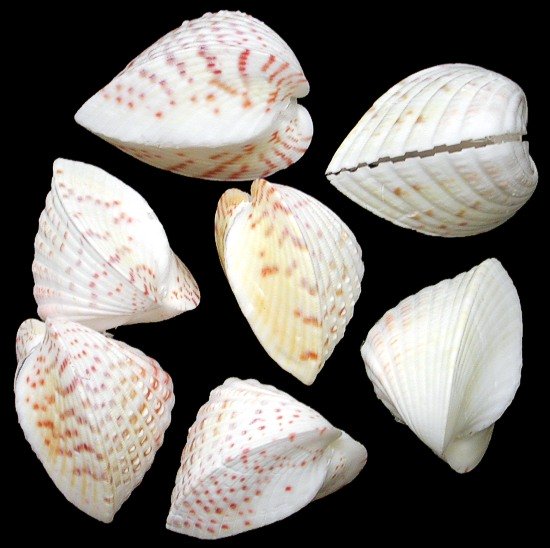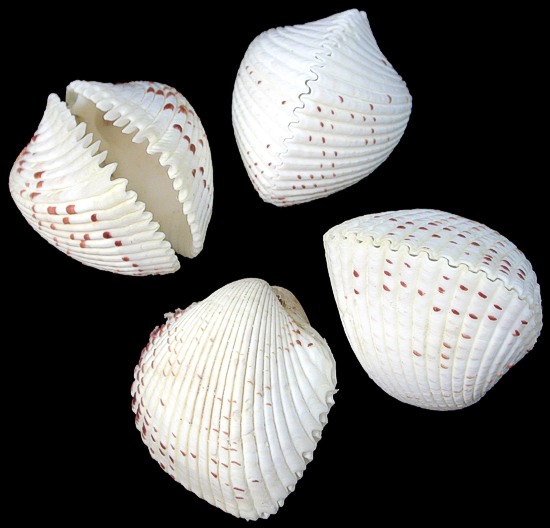As the site is updated, each listing includes the shipping cost. Some listings which I have not updated still give you calculated shipping costs based on weight and size of package. (In the sections I have updated) If you select several different listings, we will consolidate your order and charge you the actual cost of the entire package. The shipping over charge will be refunded to you, when your order is shipped.
CARDIUM SHELLS QUALITY AND VARIETY

Corculum cardissa
Common name the heart cockle, is a species of marine bivalve mollusk in the family Cardiidae. They dwell across the Indo-Pacific Region
Corculum cardissa are often found lying on a surface of sand among coral debris and broken shells. They usually rest horizontally in a hollow it excavates and their top is often covered with filamentous algae and muddy deposits.
filamentous is a fine or very thin thread or fiber
The two valves of Corculum cardissa are unequal in size and often asymmetric. Their shape is very variable but viewed from above, the outline is roughly heart shaped which gives the mollusks their common name. Viewed from the side the shape bears a resemblance to the shell of a cockle (Cerastoderma spp.). In some specimens the posterior valve is nearly flat or has a slight hump. In others it is more rounded.
The boundary of the valves is usually flat but is sometimes somewhat sinuous. Smaller shells tend to be elongated; larger shells are more rounded and the growth rings can be seen clearly. The shell is thin and translucent, particularly the upper side. There is an intricate mosaic pattern of more and less transparent white regions. The lower valve has a mainly white surface with a few transparent regions. The gills and mantle, especially the lower siphon, are dark brown owing to the presence of microscopic algae. The outer surface of the mantle also contains granules of reddish, purple and blue pigment.
sinuous means having many curves and turns.
Corculum cardissa is a filter feeder. The shell gapes slightly at the ventral end and two siphons are protruded. Water is drawn in through one and expelled through the other and plankton and detritus are extracted. At the same time, water passes over the gills where oxygen is absorbed.
gapes means to be or become wide open.
Corculum cardissa are a hermaphrodites. Eggs are laid and the larvae develop with great rapidity. Within 24 hours of fertilisation, the veliger larvae have been observed to develop two valves and be swimming on the surface of the substrate. A day later, they had undergone metamorphosis (developmental changes) and had settled on the bottom as juveniles, miniature versions of the adult bivalves.
A hermaphrodite is a sexually reproducing organism that produces both male and female gametes. Animal species in which individuals are of different sexes, either male or female but not both, are gonochoric, which is the opposite of hermaphroditic.
Gametes are haploid reproductive cells in sexually reproducing organisms that fuse with one another during fertilization.
The individuals of many taxonomic groups of animals, primarily invertebrates, are hermaphrodites, capable of producing viable gametes of both sexes. In the great majority of tunicates, mollusks, and earthworms, hermaphroditism is a normal condition, enabling a form of sexual reproduction in which either partner can act as the female or male.
taxonomic is a system for naming and organizing things, especially plants and animals, into groups
Scientific classification
Domain: Eukaryota
Kingdom: Animalia
Phylum: Mollusca
Class: Bivalvia
Order: Cardiida
Family: Cardiidae
Genus: Corculum
Species: Corculum cardissa
Binomial name: Corculum cardissa
(Linnaeus, 1758)
(REF: Corculum cardissa (Linnaeus, 1758) World Register of Marine Species.)(REF: Kawaguti, Siro. "Observations on the heart shell, Corculum cardissa (L.), and its associated Zooxanthellae" (PDF). Pacific Science.)(REF: Farmer, MA; Fitt, WK; Trench, RK (2001). "Morphology of the Symbiosis Between Corculum cardissa (Mollusca: Bivalvia) and Symbiodinium corculorum (Dinophyceae)". Biological Bulletin. 200 )(REF: Avise JC (2011-03-18). Hermaphroditism: A Primer on the Biology, Ecology, and Evolution of Dual Sexuality. Columbia University Press.)

Corculum cardissa
Cardium Unido
L1-7
Twelve complete cardium unido shell measuring 1 to 2 inches...... $9.10